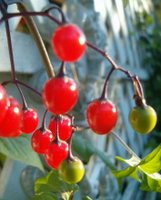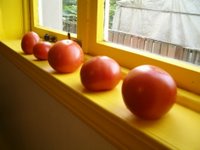







When are root enhancers excessive?
Some gardeners recommend leaving your annuals, instead of pulling them up before winter sets in. If you allow the first frost to collapse them they will decompose and add to the rich, organic content of your soil. So the theory goes.
However, if there is any mold or disease on your plants, it’s much better to pull them out and burn them, than perpetuating the infection and having it rear its ugly head again in the spring. Around this time of year, with the onset of the wet season, mold and mildew can form overnight, so it’s wise to be careful. Especially if the cold has weakened your plants and made them more susceptible to all sorts of pathogens.
Sara and I never compost diseased leaves or plants, since the harmful microbes can overwinter in the compost bin and cause problems during the next growing season. This is why it’s so important to replenish the soil with the beneficial fungi, bacteria, and microbes in Piranha, Tarantula, and Voodoo Juice, respectively.
I spent some time on the phone with the Advanced Nutrients technical expert, who mentioned that if you’re using these three root enhancers-colonizers, it’s a good idea to use them half-strength in a hydroponic situation. Even though we're growing in soil and not hydro, it’s good for us to be aware of the pitfalls of trying to help plants too much, when they don’t need it.
It seems that if you use Piranha, Tarantula, and Voodoo Juice full strength in a hydro grow, especially in conjunction with Carbo Load Liquid or Powder, the proliferation of the beneficial organisms is so great, that the roots become a mushy mess. They stop doing what they’re supposed to do, which is to suck up the nutrients to nourish the plants. If you use them at half the strength of the recommended dosage, you won’t have this problem.
Don’t get me wrong. These are very effective products and used in soil, full strength is fine. They are 100% organic and make for strong roots and healthy plants. But every time you use an additive or a supplement to your regular feeding regimen, you have to be doubly aware of what you’re doing and how the products that you are mixing work, or not work, together.
I also discussed my giving our plants Organic B and Vita Boost Pro. I mistakenly thought that Vita Boost Pro was a multi-vitamin, but it is essentially B, with some extra ingredients. It’s got B-1 (Thiamine Hydrocholoride), B-3 (Niacin), and B-6 (Pyridoxine), as well as Seaweed Extract, to provide your plants with an inexpensive source of vitamins, nutrients, natural hormones, antibiotics, enzymes, and root zone enhancers.
However, Organic-B is the world’s only 100% organic B-complex for plants, containing B-1, B-12 (Cobalamin), B-2 (Riboflavin), B-3, B-5 (Panthothenic Acid), B-6, B-7 (Biotin), and three unique yeast extract hydrolysates that contain the balanced B’s mentioned above, as well as proteins, peptides, free amino acids, and cytokinins, plus other ingredients.
When I told the Advanced Nutrients technical man that I thought that Vita Boost Pro was a multi-vitamin, he explained that plants differ from humans in that they don’t seem to need additional vitamins, other than B’s. I suspect they get Vitamin D from sunlight, but some leaves and many fruits contain vitamin C, which is made by the plants.
Organic B costs more, but it’s worth it, since it gives so much more to our flowers and vegetables. If you use B52, for instance, which is the synthetic equivalent of Organic B, then using Vita Boost Pro would be duplicating your efforts. If I had to choose, I’d go with Organic B and leave the Vita Boost Pro for those who can’t afford the more expensive product.
For enzymes, we use SensiZym. When used with its sister products Voodoo Juice, Tarantula, and Piranha, the 88 beneficial enzymes in SensiZym help our plants utilize water and water-borne elements to increase growth, yield, and drought resistance. The enzymes break down root zone components to increase absorption of carbohydrates, starches, and other elements necessary for our plants to thrive.
Sara has cut out yoghurt containers with zig-zag edges to keep the slugs in the spring from devouring her sprouting gladioli. Our tomato crop is ripening on all of our window ledges, some of our plants are still thriving such as the yarrow and the mystery plant on our back stairs, and we’re planting more bulbs for the spectacular daffodil-crocus-tulip canopy in the spring.
Our male cat Pinta is curling up on the blue tarp covering our trampoline, which is Hedgehog’s favorite form of exercise. Jim likes to lie in the middle of it in the summer and read comic books, but when it comes to jumping, his sister wins hands down. Or should I say feet down?
posted by Tim at
9:06 PM
![]()

0 Comments:
Post a Comment
<< Home